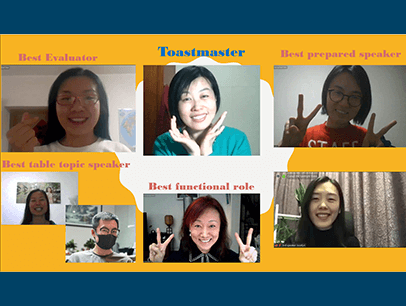
In early 2020, online meetings abruptly became the norm for Toastmasters clubs. Now, as pandemic restrictions and health concerns ease in many parts of the world, hybrid meetings are likely to become increasingly common—and this format will present another new challenge.
A few months into the pandemic, I organized a workshop on hybrid clubs, partly to help me learn more about the subject. I already knew about speaking and presenting in a virtual environment—three years earlier, I had helped charter Online Presenters. I had also organized the first hybrid meeting for my home club, Club Awesome Toastmasters in Coral Springs, Florida, in March 2020, right before our meeting venue closed. These experiences have helped me figure out some best practices to allow members on both sides of the camera to have a great experience.
Click play to hear an exclusive interview with Toastmaster Markus Seppälä and the hosts of the Toastmasters Podcast.
What Is a Hybrid Meeting?
A hybrid meeting combines both in-person and online participants, and offering an equally positive experience to both audiences can be a tricky balance.
That said, hybrid meetings are worth trying when your club is ready. The ramifications of the past year will be felt for a long time, and we are likely looking at a new normal. As long as COVID-19 remains a concern, some members will be reluctant to return to in-person meetings, while for others the convenience of meeting online has made attending meetings easier. For others, the advent of online meetings has allowed them to join clubs around the world. There are also members who have sorely missed in-person meetings and are ready to give safe get-togethers a try. As restrictions in your area ease, a hybrid model might be worth an experiment. You can always vote on the format officially at a later time.
So how can you meet the hybrid challenge, making sure both audiences can see, hear, and share equally in the meeting?
Make Sure Everyone Can Hear
Without question, sound is the biggest stumbling block to hybrid meeting quality. You’ll need a microphone in the meeting room, positioned close to the speaker, and you’ll want to make sure other mics in phones or laptops are turned off, because more than one live mic will cause audio problems.
“There has to be the willingness of people to try, and to realize it’s not going to be perfect the first time.”
—Birgit Starmanns, DTMYou will also need a speaker (in this case, a sound output device, not the meeting role). Portable speakers can be connected to the computer that is logged into your online meeting tool. Zoom and other meeting tools include sound cancellation software that helps prevent feedback, provided that both mic and speaker are plugged into the same computer. You may want a second speaker in the room, but it should be placed far from the mic.
You can either use a wireless microphone and hand it from one person to the next, or use a standard microphone at the lectern and have everyone come there to speak (be sure to wipe both down before each speaker). A conference room speaker/microphone could be a third option.
Make Sure Everyone Can See
Consider the placement of webcams and displays or projector screens—you want to make sure members on both sides can see and understand what is going on. It’s helpful to have one camera on the in-person speaker and another on the in-person audience. That way, remote participants can see both the speakers and the audience. The faces of online participants can be displayed on a projector screen or television in your meeting room.
And finally, remember that if the timer is in the physical room, you’ll need to ensure the timing cards or device can be seen by the speaker, wherever they may be.
Hybrid Meetings for Clubs
Graham Cairns, DTM, of Upper Mount Gravatt, Queensland, Australia, has been coaching several clubs on how to conduct hybrid meetings. Some of these clubs prefer the hybrid format, not only because of COVID-19 concerns but because it allows them to reach more members geographically, something particularly helpful given Australia’s wide-open spaces.
Cairns recommends that clubs start simply, depending on equipment provided by a tech-savvy member, making sure club members enjoy the mixed-format experience before committing money to it. He also cautions about one drawback to hybrids: Club members in the physical space might become less aware of online participants and not include them fully in the meeting. “Everybody should be part of the club, and everyone should be part of the meeting,” Cairns notes.
Birgit Starmanns, DTM, of Mountain View, California, says there is also a long-term professional value to learning business-applicable technology. As a California employee of the German software company SAP, she has participated in hybrid meetings for years, and acknowledges hybrid meetings might be bumpy at first.
“Everybody should be part of the club, and everyone should be part of the meeting.”
—Graham Cairns, DTMFor Toastmasters, “there has to be the willingness of people to try, and to realize it’s not going to be perfect the first time,” she says. Flexibility and patience are key to experimenting with the hybrid format.
“We’re in a low-risk environment where we can experiment, and fail, and ask for help—and we should take that opportunity,” agrees Markus Seppälä, Vice President Education at Basel International Speakers in Basel, Switzerland. After a few months online, his club went hybrid. However, in-person attendance has recently tapered off, due to renewed COVID-19 concerns and border crossing issues for members from France and Germany. “When people are coming to the meeting, I don’t ask whether they’ll attend virtually or in person—because I don’t care,” Seppälä says. He has documented what he has learned in tutorial videos and shared equipment recommentations.
Agostinho Cajetan Barretto, DTM, based in New York City, has created a wealth of information on hybrid meetings and technology. He is a District 20 Division Director and a member of six clubs in the United States and Kuwait, and was among Toastmasters recognized in the 2020 Masters of Online Meetings series. Barretto recently led two hybrid meeting demonstration meetings, one from a well-equipped corporate conference room, and another using basic consumer technology and free software. The high-tech session was easier but the basic equipment “worked just fine,” Barretto says.
Ultimately, if your club decides to give hybrid meetings a try, your ideal set-up will depend on member preferences, budget, meeting facilities, and the tech aptitudes of members.
Don’t underestimate the hybrid challenge, but don’t be afraid of it, either.
Need more help setting your club up for a hybrid format? Watch this workshop with members from Invicta Toastmasters in Porto, Portugal.
David F. Carr, DTM is a writer, editor, and digital consultant based in Coral Springs, Florida. He is a member of Online Presenters and of Club Awesome in Coral Springs. He is also the founder of the WordPress for Toastmasters project and runs the Toastmost.org club website hosting service.
Related Articles

Online Meetings
It's Time to Meet Online!

Technology
Prepare Your Technology Like a Pro

Online Meetings



 Previous
Previous
 5 Questions to Ask Before Adopting a Hybrid Format
5 Questions to Ask Before Adopting a Hybrid Format
 Previous Article
Previous Article